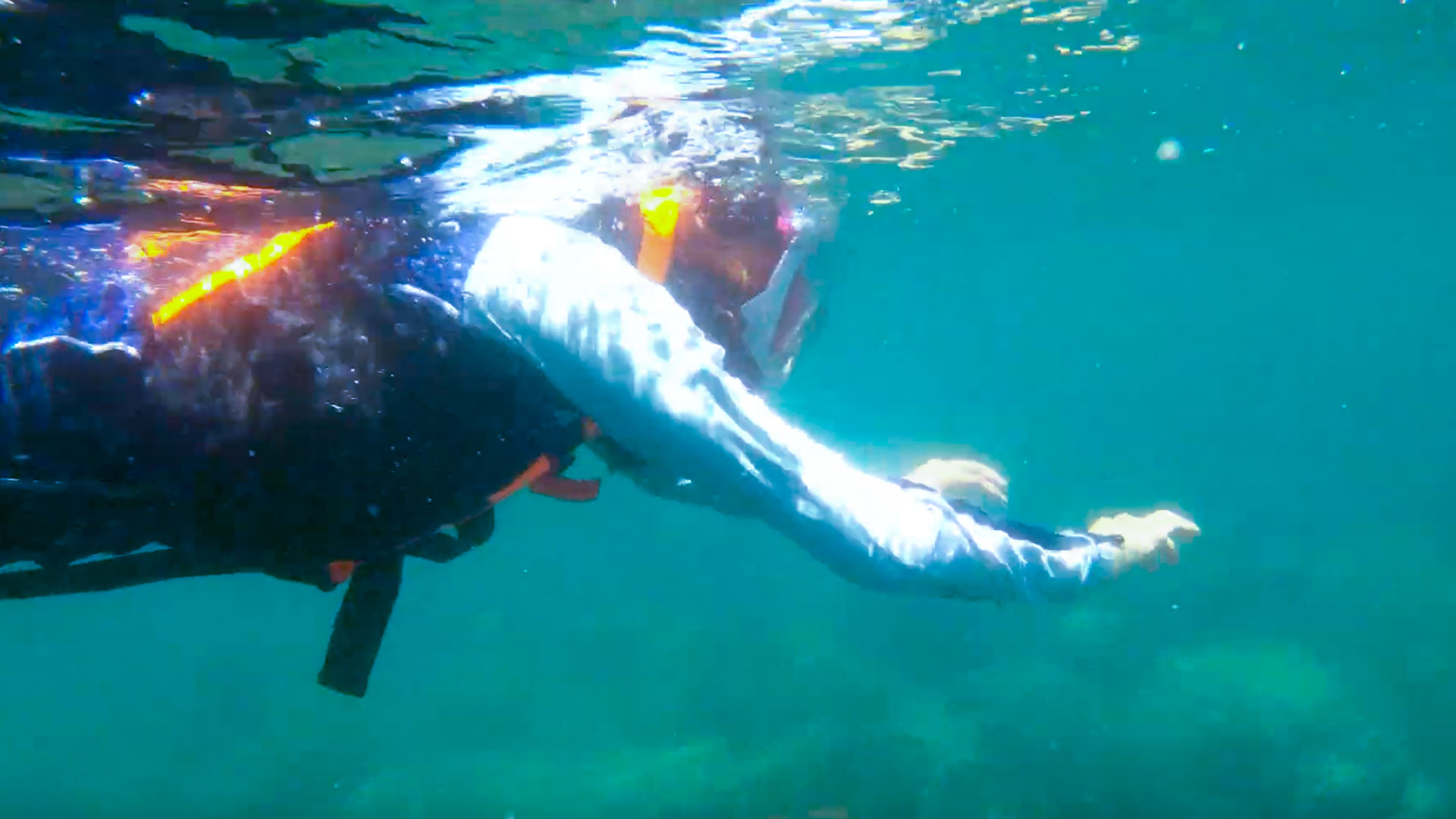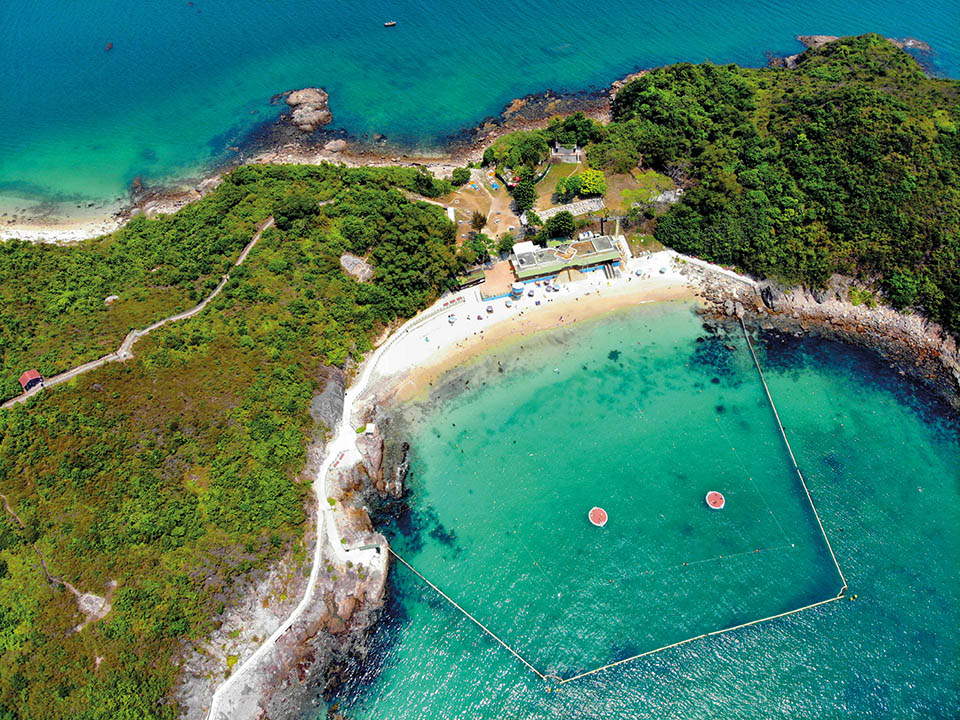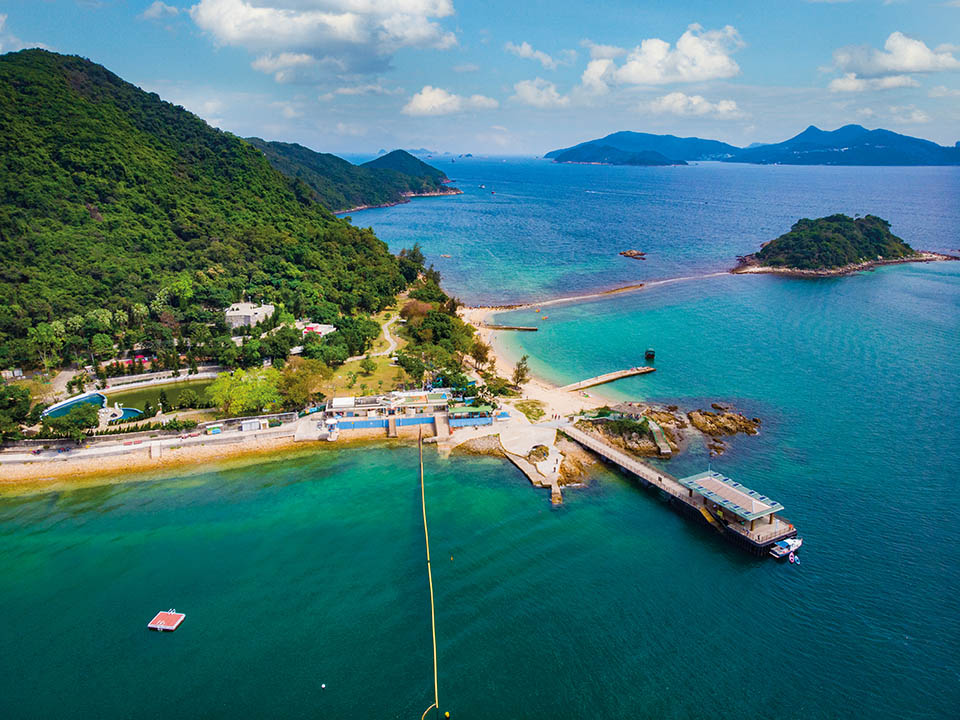The Immersive Light Show in Central will be suspended on 31 December, while the Christmas Town will close at 4pm on that day to prepare for the Hong Kong New Year Countdown activities.
The “Hong Kong New Year Countdown” will showcase a spectacular music and light show at Central’s landmarks. Locals and visitors can also join the celebration across multiple platforms, with new Countdown Live Zones and online broadcasts to share well wishes for the New Year. Click here for details.

Written by South China Morning Post (Morning Studio)
Many Hongkongers go snorkelling in the city’s coastal waters during the hot summer months. You needn’t be an athlete to enjoy this water sport because the city is home to many sites with calm shallows suitable for beginners. One excellent location is Sharp Island (or Kiu Tsui Chau), a short kaito (ferry boat) ride from Sai Kung, in the New Territories. The island, stretching 2,500 metres from north to south, offers idyllic beaches, stunning geology, panoramic vistas of mountains and islands and — just beneath the waves — a long, unbroken coral reef teeming with colourful marine life.
-
Sharp Island
Kiu Tsui Beach, stretching from the north to the west, is one of the two beaches on Sharp Island (the other one is Hap Mun Beach in the south). There is a beach kiosk selling bottled water, soft drinks and beer, but you should bring your own lunch and supplies. You can either relax on the beach or explore the surrounding rocky shoreline. Kiu Tsui Beach is connected to Hap Mun Beach by a 2km-long hiking trail. Once on the trail, you will pass through the forest to the ridge of the island, which offers a stunning panorama of the sea, islands and mountains, whichever way you turn. Viewing platforms even offer stands for your phone for taking selfies to capture the occasion.
 To protect corals and other marine life, a ‘non-anchoring area’ has been set up on the western side of Sharp Island. Boat operators should avoid anchoring their boats inside this area, and should avoid sailing over any shallow coral areas nearby. For snorkellers, please check the seabed environment before entering the water to avoid stepping on corals. Beginners should practise snorkelling techniques away from the coral areas and avoid standing and resting on corals, touching anything with their flippers, or stirring up sediment on the seabed. For more information on how to protect marine life, please visit the Agriculture, Fisheries and Conservation Department’s website.
Get me there
To protect corals and other marine life, a ‘non-anchoring area’ has been set up on the western side of Sharp Island. Boat operators should avoid anchoring their boats inside this area, and should avoid sailing over any shallow coral areas nearby. For snorkellers, please check the seabed environment before entering the water to avoid stepping on corals. Beginners should practise snorkelling techniques away from the coral areas and avoid standing and resting on corals, touching anything with their flippers, or stirring up sediment on the seabed. For more information on how to protect marine life, please visit the Agriculture, Fisheries and Conservation Department’s website.
Get me there
-
Tombolo
Sharp Island’s signature vista is the tombolo — a narrow strip of land formed of rocks and sand on its western side — which connects the main island with the islet of Kiu Tau. When the tide is low, you can walk across without getting your feet wet. Make sure you take photos of the impressive pineapple-textured boulders. The short hike around the islet leads you down to a small beachhead on the other side and a hidden lighthouse. Some of Hong Kong’s best snorkelling areas lie just a few hundred metres south of the tombolo. While snorkelling, you may see many corals of various colours and shapes, including the wavy, undulating cactus coral (Pavona spp.), where fish, crabs and sea urchins sometimes squeeze themselves within its folds. You may also spot large spheres of elaborately grooved brain coral (Platygyra spp.), and delicately swaying bowl coral (Turbinaria spp.). But the water is shallow, so be careful not to tread on the fragile coral. Living amid the coral you may also see stripy sergeant fish, schools of yellow-tailed Chinese demoiselles, multi-coloured wrasses, and various vivid butterfly fish. If you are lucky, you can even spot the Yellowtail clownfish, which is a close relative of the titular fish featured in Disney’s Finding Nemo. You may also watch out for the fierce-looking scorpion fish in the rocky reef, and try spotting the butterfly rays that usually half-bury themselves in the sandy patches.
 When appreciating the beauty and diversity of marine life in Hong Kong waters, please respect the marine environment and take note of the ‘Marine Conservation Codes’ — do not hurt or disturb any marine wildlife, do not touch or stand on the corals, do not dig up sand and rubbles, do not overturn stones and boulders, and do not collect any live or dead specimens. Snorkellers should also pay attention to avoid some potentially dangerous marine life. For more information, please visit the AFCD’s website on Marine Conservation Codes and Dangerous Marine Life in Hong Kong.
Get me there
When appreciating the beauty and diversity of marine life in Hong Kong waters, please respect the marine environment and take note of the ‘Marine Conservation Codes’ — do not hurt or disturb any marine wildlife, do not touch or stand on the corals, do not dig up sand and rubbles, do not overturn stones and boulders, and do not collect any live or dead specimens. Snorkellers should also pay attention to avoid some potentially dangerous marine life. For more information, please visit the AFCD’s website on Marine Conservation Codes and Dangerous Marine Life in Hong Kong.
Get me there
-
Sai Kung Town Centre
Snorkelling, swimming and hiking will work up an appetite, and Sai Kung is the ideal place to eat out — both before and after the trip — prior to heading back to the city. Many visitors dine at one of the many waterfront Chinese seafood restaurants near the minibus terminus. Alternatively, walk past them and take your pick of numerous Western and Thai restaurants along Yi Chun and Man Nin streets and in the surrounding alleys. If you are in a hurry, head to the alley facing the minibus terminus where you can find more than a dozen small restaurants selling a range of food, noodles and local delicacies.
Get me there

Transport
Getting to Sharp Island
MTR Choi Hung Station’s Exit C2 leads to the 1A minibus stop, which goes to the terminus near Sai Kung Pier. You can also take bus 92 from MTR Diamond Hill Station, which stops at Sai Kung bus terminus near the public pier. On the waterfront and at the Sai Kung New Public Pier, a number of small kaito operators — each with a distinctive flag — offer return trips to Sharp Island. They will drop you off at Kiu Tsui Pier. When you buy your ticket, they will inform you of the return schedule. Make sure you keep the ticket for your return — and look out at the pier for your kaito’s flag.
Leaving from Sharp Island
Take the kaito from Kiu Tsui Pier back to Sai Kung, and minibus 1A from the minibus terminus to MTR Choi Hung Station, or bus 92 from the bus terminus back to MTR Diamond Hill Station.

Local Tour
Summer Sai Kung Snorkelling Experience Half-Day Tour
Operating from 9:30am to 1pm or 2–5:30pm, the tour includes 15 minutes of briefing and demonstration, 2–2.5 hours of snorkelling experience in the sea, rental of snorkelling equipment, and return ferry transfer between Sai Kung Ferry Pier and Sharp Island. Snorkellers will be accompanied and instructed by a snorkelling guide. Open to adults and children aged eight or above. Please refer to the company’s website for details.
Go Green Travel (HK)
Tel #: +852 2111 1880
Website: http://www.gogreentravelhk.com
Disclaimer:
Details of the local tours are subject to the terms and conditions of the operators. The Hong Kong Tourism Board and the local operators reserve the right to amend, change or cancel any details concerning the tours at any time without prior notice. Customers can refer to the local operators if they have any enquiries.
More Routes

Written by South China Morning Post (Morning Studio)
Many Hongkongers go snorkelling in the city’s coastal waters during the hot summer months. You needn’t be an athlete to enjoy this water sport because the city is home to many sites with calm shallows suitable for beginners. One excellent location is Sharp Island (or Kiu Tsui Chau), a short kaito (ferry boat) ride from Sai Kung, in the New Territories. The island, stretching 2,500 metres from north to south, offers idyllic beaches, stunning geology, panoramic vistas of mountains and islands and — just beneath the waves — a long, unbroken coral reef teeming with colourful marine life.

Transport
Getting to Sharp Island
MTR Choi Hung Station’s Exit C2 leads to the 1A minibus stop, which goes to the terminus near Sai Kung Pier. You can also take bus 92 from MTR Diamond Hill Station, which stops at Sai Kung bus terminus near the public pier. On the waterfront and at the Sai Kung New Public Pier, a number of small kaito operators — each with a distinctive flag — offer return trips to Sharp Island. They will drop you off at Kiu Tsui Pier. When you buy your ticket, they will inform you of the return schedule. Make sure you keep the ticket for your return — and look out at the pier for your kaito’s flag.
Leaving from Sharp Island
Take the kaito from Kiu Tsui Pier back to Sai Kung, and minibus 1A from the minibus terminus to MTR Choi Hung Station, or bus 92 from the bus terminus back to MTR Diamond Hill Station.

Local Tour
Summer Sai Kung Snorkelling Experience Half-Day Tour
Operating from 9:30am to 1pm or 2–5:30pm, the tour includes 15 minutes of briefing and demonstration, 2–2.5 hours of snorkelling experience in the sea, rental of snorkelling equipment, and return ferry transfer between Sai Kung Ferry Pier and Sharp Island. Snorkellers will be accompanied and instructed by a snorkelling guide. Open to adults and children aged eight or above. Please refer to the company’s website for details.
Go Green Travel (HK)
Tel #: +852 2111 1880
Website: http://www.gogreentravelhk.com
Disclaimer:
Details of the local tours are subject to the terms and conditions of the operators. The Hong Kong Tourism Board and the local operators reserve the right to amend, change or cancel any details concerning the tours at any time without prior notice. Customers can refer to the local operators if they have any enquiries.











-10-en.jpg)
-18-en.jpg)



